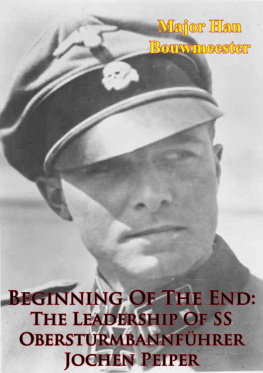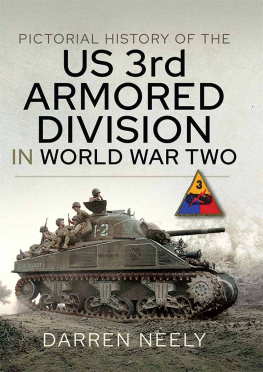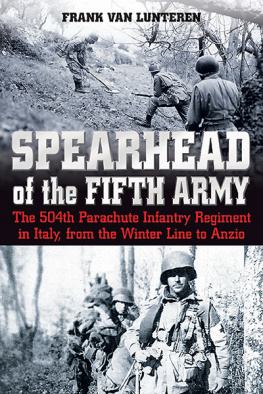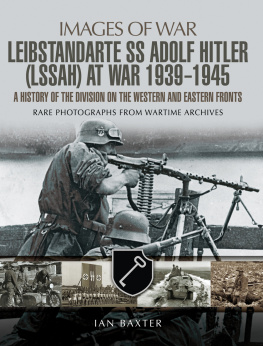
This edition is published by PICKLE PARTNERS PUBLISHINGwww.picklepartnerspublishing.com
To join our mailing list for new titles or for issues with our books picklepublishing@gmail.com
Or on Facebook
Text originally published in 2004 under the same title.
Pickle Partners Publishing 201 3, all rights reserved. No part of this publication may be reproduced, stored in a retrieval system or transmitted by any means, electrical, mechanical or otherwise without the written permission of the copyright holder.
Publishers Note
Although in most cases we have retained the Authors original spelling and grammar to authentically reproduce the work of the Author and the original intent of such material, some additional notes and clarifications have been added for the modern readers benefit.
We have also made every effort to include all maps and illustrations of the original edition the limitations of formatting do not allow of including larger maps, we will upload as many of these maps as possible.
BEGINNING OF THE END:
THE LEADERSHIP OF
SS OBERSTURMBANNFHRER
JOCHEN PEIPER
by
HAN BOUWMEESTER, MAJ, ROYAL NETHERLANDS ARMY
M.A., Free University of Amsterdam, The Netherlands, 2000
TABLE OF CONTENTS
Contents
ABSTRACT
BEGINNING OF THE END: THE LEADERSHIP OF SS OBERSTURMBANNFHRER JOCHEN PEIPER, by Han Bouwmeester.
SS Obersturmbannfhrer Jochen Peiper was one of Germanys most colorful military commanders of World War II with a reputation for conducting extremely daring operations. The name Peiper will always be linked to the Malmdy Massacre, the death of Belgian civilians and more than seventy American soldiers. Peiper at the very young age of twenty-nine had been chosen to lead the spearhead unit (Kampfgruppe Peiper) during the Battle of the Bulge, the German offensive through the Ardennes in December 1944. Peiper commanded a platoon up to a regiment within the Leibstandarte, one of the most elite divisions within the Waffen-SS. He was an exponent of the tough SS leadership. Peiper was charismatic and extreme loyal to his unit. He was also a smart independent thinker. His men trusted him as a leader, even under the most extreme conditions. It was a logical decision that Peiper became the commander of the spearhead unit, but there were factors other than leadership leading to this decision, such as tactical considerations and a we-know-what to-expect-principle. Last but not least, Peiper was lucky that he was still serving in the Leibstandarte in December 1944.
ACKNOWLEDGMENTS
Beginning of the End is the title of this Master in Military Art and Science (MMAS) thesis on the leadership of SS Obersturmbannfhrer Jochen Peiper. The Battle of the Bulge was indeed the turning point in Peipers life. In the years prior to this operation Peiper was heroic and a very popular German tactical commander. He became Germanys poster boy, but that changed dramatically after the Battle of the Bulge: Peiper was accused of committing war crimes at Malmdy without real hard evidence. He was sentenced to death; later changed into life imprisonment. Finally, he spent almost ten years in prison in solitary confinement. After release he was not able to make a living in Germany. He was disappointed and went to France, where he has been murdered by what is believed French communists.
It is still very sensitive to study the leadership of a Waffen-SS officer, who was sentenced to death. Many people see Peiper only as a representative of a very evil organization. I can imagine that. There is a very dark side to Peipers leadership. Nevertheless, World War II took place more than sixty years ago. The time has come to reflect on all aspects of this war; not only glorifying the actions of the Allies and stigmatizing the proceedings of the Germans as evil. Units as the Leibstandarte achieved a lot of success. There are many positive things to learn from these German units; even for todays modern armies. In the case of Jochen Peiper: Why was a twenty-nine year old Waffen-SS officer the first choice for commanding the spearhead unit during Germanys most important offensive? He must have impressed his seniors with his leadership in the period prior to the Battle of the Bulge. But, what made him such a successful leader? These interesting questions became the nucleus of my research.
I would like to thank my thesis committee, Dr. Richard Olsen (Chair), LTC John Suprin (2nd Reader) and Dr. Mike Ray (3d Reader), for their tremendous support, advice and sometimes challenging academic discussions. I would also like to thank LTC Joseph Ryan of the Combat Studies Institute for the excellent help he gave to win my War on the American English Language. Another person to thank is Mrs. Helen Davis, the secretary of the MMAS Program and a real specialist on Kate Turbanians A Manual for Writers , for all the advices she provided to make this thesis a real MMAS thesis.
Last but not least I would like to thank my family for all their support. Unbelievable how much patience my wife Joke had with me. I spent many hours behind my computer doing MMAS. Many other international officers with their families discovered the New World during the weekend holidays; we stayed at home for the MAS thesis. Joke always supported me very much: cooking, cleaning, being charming at the many international parties, running the family and entertaining the children in the weekends, because Daddy has to concentrate on the MMAS thesis in his study. And during Sunday evenings, when I had finished another chapter, Joke advised me to take some rest while she could read my crappy draft versions; making corrections and asking me nasty academic questions on black holes in the text. In return of all this, I promised my family to show all the nice places, discussed in this thesis, in the Belgian Ardennes as soon as we are back in Europe. Not doing a battlefield tour, but spending quality time with my family in a very nice surrounding.
ACRONYMS
AAAAnti Aircraft Artillery
C of SChief of Staff
HrsHours
MMASMaster in Military Art and Science
NATONorth Atlantic Treaty Organization
NaziNational Socialismus
OKHOberkommando des Heeres (High Command of the Army)
OKWOberkommando des Wehrmacht (High Command of the Armed Forces)
SASturm Abteilung
SSSchutz Staffel
SS TVSchutz Staffel Totenkopf Verbande
SS VTSchutz Staffel Verfgungstruppen
WSSOBWaffen-SS Order of Battle
U.S.United States
III / LAH3d Battalion / Leibstandarte Adolf Hitler
TABLES
Table 1. Tools for Leadership
Table 2. The Four Kampfgruppe Commanders in the Leibstandarte
Table 3. Max Wnsche and Jochen Peiper
Table 4. Similarities between Erwin Rommel and Jochen Peiper
Table 5. Tools for Leadership
ILLUSTRATION
Figure 1. Factors Leading to the Decision of Peiper as Spearhead Unit Commander
CHAPTER 1 INTRODUCTION
Preamble
The study of leadership has preoccupied many professions--business managers, trainers and coaches in sports and politicians--but by far it is the primary preoccupation of soldiers. Leadership is really important to the military profession, because armed forces are always focused on reaching a target with a group of people, sometimes under extreme conditions, and that requires leadership. Military leaders, such as Julius Caesar, Frederick the Great, Napoleon Bonaparte, the Duke of Wellington and Dwight D. Eisenhower, all had an enormous impact on history. These well-known commanders are still a source of inspiration for new generations of leaders. But what actually is leadership? The Netherlands Army doctrine gives the following explanation for leadership:






